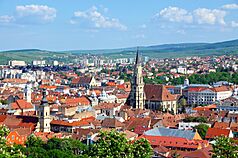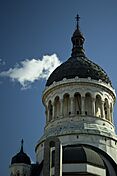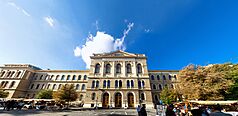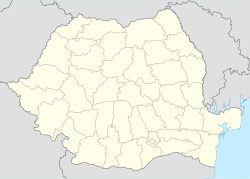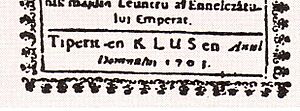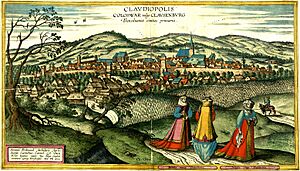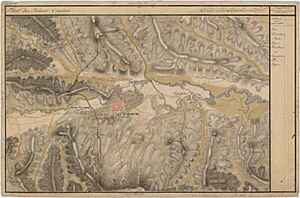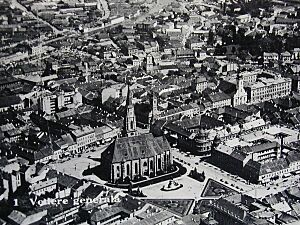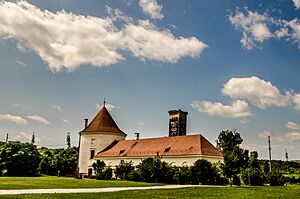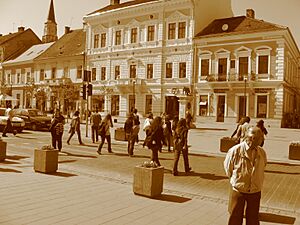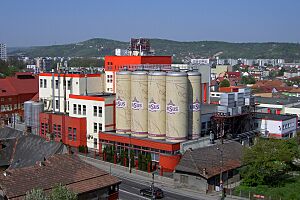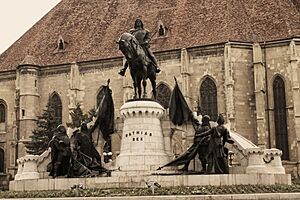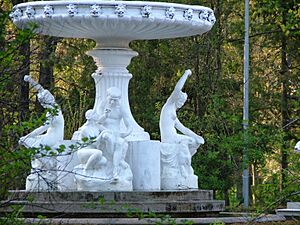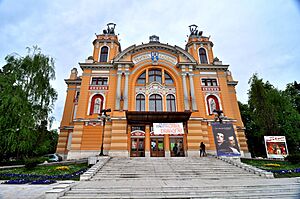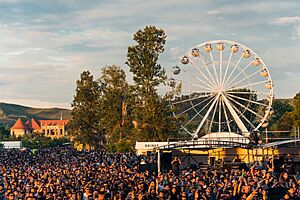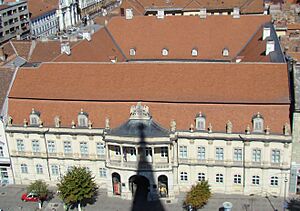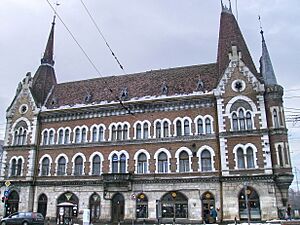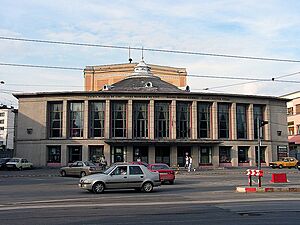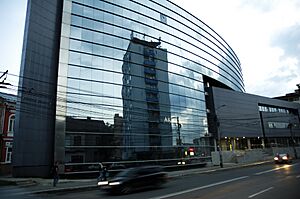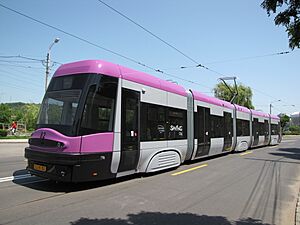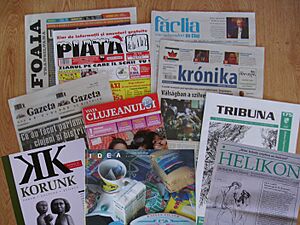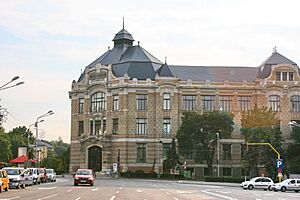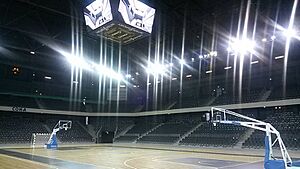Cluj-Napoca facts for kids
Quick facts for kids
Cluj-Napoca
|
||
|---|---|---|
|
Cluj-Napoca panorama
Dormition of the Theotokos Cathedral
St. Michael's Church
Matthias Corvinus House
Romanian National Opera
Babeș-Bolyai University
|
||
|
||
| Nickname(s): | ||
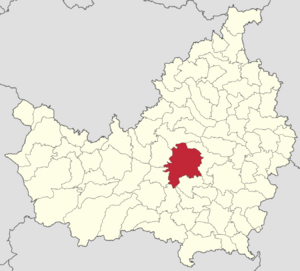
Location in Cluj County
|
||
| Country | Romania | |
| County | Cluj County | |
| Status | County seat | |
| Attested | 1213 (first official record as Clus) | |
| Area | ||
| • City | 179.5 km2 (69.3 sq mi) | |
| • Metro | 1,537.5 km2 (593.6 sq mi) | |
| Elevation | 340 m (1,120 ft) | |
| Population
(2021)
|
||
| • City | 286,598 | |
| • Density | 1,597/km2 (4,140/sq mi) | |
| • Metro
(2011)
|
411,379 | |
| Time zone | UTC+2 (EET) | |
| • Summer (DST) | UTC+3 (EEST) | |
| Postal Code |
400xyz
|
|
| Area code(s) | +40 x64 | |
| Car Plates | CJ | |
Cluj-Napoca, often called just Cluj, is a big city in northwestern Romania. It's the second largest city in the country and the main city of Cluj County. You can find it in the valley of the Someșul Mic river. Many people think of it as the unofficial capital of the historical region of Transylvania. Long ago, before 1867, it was the official capital of the Grand Principality of Transylvania.
As of 2021, about 286,598 people live in Cluj-Napoca. If you include the areas around it, the population is much larger, around 411,379 people. The city is built around St. Michael's Church in Unirii Square. This church was built in the 14th century and is named after Archangel Michael, who is the city's patron saint. The city covers an area of about 179.52 square kilometers.
After a tough time in the 1990s, Cluj-Napoca has become one of Romania's most important places for learning, culture, business, and industry. It's home to Babeș-Bolyai University, which is the biggest university in Romania. The city also has famous cultural spots like the National Theatre and Opera. Cluj-Napoca was even named the European Youth Capital in 2015 and a European City of Sport in 2018. In 2021, it joined UNESCO's Creative Cities Network as a UNESCO City of Film.
Contents
What's in a Name?
Napoca
Long before the Romans arrived, there was a settlement here called Napoca. When the Romans conquered the area in AD 106, they called it Municipium Aelium Hadrianum Napoca. The name Napoca might come from old Dacian tribes or a Greek word meaning "timbered valley." It could also be from an ancient word meaning "to flow."
Cluj
The first time the name Cluj was written down was in 1213. It was called Castrum Clus, which means "Clus Castle" in Latin. The name Clus might come from a Latin word meaning "closed place" or "ravine," because the valley here narrows between hills. It could also be from a Slavic word meaning "key" or a German word for "mountain pass." Another idea is that it's named after an early leader, Miklus.
The Hungarian name for the city is Kolozsvár, and the German name is Klausenburg. The Romanian name used to be Cluj or Cluș.
Why "Cluj-Napoca"?
The name "Napoca" was added to "Cluj" in 1974. This happened during the time of Nicolae Ceaușescu, a former leader of Romania. He wanted to show how old the city's roots were, going back to Roman times. Outside of official documents, most people still just call it "Cluj."
The "Treasure City" Nickname
Cluj-Napoca got the nickname "Treasure City" in the late 1500s. This name refers to how wealthy the people living there became, especially from trading valuable metals. In Hungarian, it's kincses város, and in Romanian, it's orașul comoară.
A Look Back in Time
Roman Times
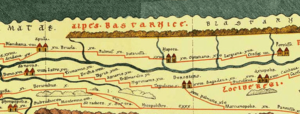
The Roman Empire took over the area of Dacia in AD 101 and 106. The Roman settlement of Napoca was started around 106 AD. It grew into an important city and even became a provincial capital. However, the Romans left in 274 AD, and there's not much record of a city here for a long time after that.
The Middle Ages
In the early Middle Ages, there were two small settlements where Cluj-Napoca is now. One was a wooden fort, and the other was a village. The area became part of the Kingdom of Hungary. In 1316, King Charles I of Hungary gave Cluj the special status of a "city." This was a reward for the help of the Transylvanian Saxons who had settled there.
During the 14th and 15th centuries, many craft guilds (groups of skilled workers) were formed. The city became a center for trade and crafts. In 1488, King Matthias Corvinus, who was born in Cluj, made sure that the city council included both wealthy citizens and craftsmen. For a while, the council had an equal number of Hungarian and Saxon representatives. In 1541, Cluj became part of the Eastern Hungarian Kingdom, which later became the Principality of Transylvania. This was a time of growth for the city.
16th to 18th Centuries
In the 1500s, new religious ideas from the Protestant Reformation arrived in Cluj. Unitarianism, a religion that allowed people to interpret the Bible freely, became important here. Later, the city became part of the Habsburg monarchy in 1699.
The 17th century was difficult for Cluj, with diseases like the plague and big fires. But the city slowly became important again in Transylvania. In 1791, a group of Romanian thinkers wrote a petition called Supplex Libellus Valachorum. They asked for equal rights for Romanians in Transylvania, but the local government in Cluj said no.
19th Century Changes
In the 1800s, Cluj became a center for the Hungarian national movement in Transylvania. After the Austro-Hungarian Compromise of 1867, Transylvania, including Cluj, became part of the Kingdom of Hungary again. A modern university was founded in 1872. Romanians in Transylvania faced challenges during this time. In 1892, Romanian leaders sent a petition to the Emperor asking for equal rights and an end to attempts to make everyone speak Hungarian. The authors were arrested, but later pardoned.
The 20th Century and Beyond
After World War I, in 1918, Cluj became part of the Kingdom of Romania. The new Romanian authorities worked to highlight Romanian culture in the city. For example, a statue of the Capitoline Wolf (a symbol of Rome) was put up, and a large Orthodox cathedral was built.
In 1940, during World War II, Cluj became part of Hungary again for a few years. During this time, many Jewish people from Cluj were sent to concentration camps. The city was taken by Romanian and Soviet troops in 1944 and officially returned to Romania in 1947.
After the war, during the Communist period, Cluj grew a lot. Many new factories and apartment buildings were constructed. In 1974, the government added "Napoca" to the city's name to emphasize its ancient roots.
During the Romanian Revolution of 1989, Cluj-Napoca was a place of protests. After the Communist rule ended, the city went through some changes. A mayor named Gheorghe Funar was in office for 12 years, and his time was known for strong Romanian nationalism. However, since 2004, the city has seen fast economic growth.
City and Nature
Cluj-Napoca is in the middle of Transylvania. It sits where the Apuseni Mountains, the Someș plateau, and the Transylvanian plain meet. The city spreads out along the valleys of the Someșul Mic and Nadăș rivers. Hills surround the city on three sides, with heights between 500 and 700 meters.
The city has many parks, and the biggest is the Central Park. It has a lake and the Chios casino. The Cluj-Napoca Botanical Garden is also a beautiful place with many different plants.
Around the City
The area around Cluj-Napoca has forests and grasslands. You can find rare plants and animals like boars and foxes in nearby forests like Făget and Hoia. The Hoia forest is also famous for stories of strange events and even UFO sightings!
There's a ski resort on Feleac Hill, and other winter resorts nearby. You can also find old castles built by wealthy families, like the Bonțida Bánffy Castle, sometimes called "the Versailles of Transylvania." The Nicula Monastery is an important pilgrimage site, known for a special Madonna icon.
Weather in Cluj-Napoca
Cluj-Napoca has a climate with warm summers and cold winters. Winter temperatures are often below freezing, and snow usually covers the ground for about 65 days. In summer, the average temperature is around 20°C, but it can get hotter. Spring and autumn have milder rain. The city is known for having very good air quality in the European Union.
People of Cluj-Napoca
| Historical population of Cluj-Napoca | |||||||||||||
| Year | Population | %± | Romanians | Hungarians | |||||||||
|---|---|---|---|---|---|---|---|---|---|---|---|---|---|
| 1453 est. | 6,000 | — | N/A | N/A | |||||||||
| 1703 | 7,500 | 25% | N/A | N/A | |||||||||
| 1714 | 5,000 | −33.3% | N/A | N/A | |||||||||
| 1770 | 10,500 | 110% | N/A | N/A | |||||||||
| 1785 | 9,703 | −7.6% | N/A | N/A | |||||||||
| 1787 | 10,476 | 7.9% | N/A | N/A | |||||||||
| 1835 | 14,000 | 33.6% | N/A | N/A | |||||||||
| 1850 | 19,612 | 40% | 21.0% | 62.8% | |||||||||
| 1880 | 32,831 | 67.4% | 17.1% | 72.1% | |||||||||
| 1890 | 37,184 | 13.2% | 15.2% | 79.1% | |||||||||
| 1900 | 50,908 | 36.9% | 14.1% | 81.1% | |||||||||
| 1910 census | 62,733 | 23.2% | 14.2% | 81.6% | |||||||||
| 1920 | 85,509 | 36.3% | 34.7% | 49.3% | |||||||||
| 1930 census | 100,844 | 17.9% | 34.6% | 47.3% | |||||||||
| 1941 | 114,984 | 14% | 9.8% | 85.7% | |||||||||
| 1948 census | 117,915 | 2.5% | 40% | 57% | |||||||||
| 1956 census | 154,723 | 31.2% | 47.8% | 47.9% | |||||||||
| 1966 census | 185,663 | 20% | 56.5% | 41.4% | |||||||||
| 1977 census | 262,858 | 41.5% | 65.8% | 32.8% | |||||||||
| 1992 census | 328,602 | 25% | 76.6% | 22.7% | |||||||||
| 2002 census | 317,953 | −3.2% | 79.4% | 19.0% | |||||||||
| 2011 census | 324,576 | 2.1% | 81.5% | 16.4% | |||||||||
| 2021 census | 286,598 | −11.7% | 84.6% | 13.9% | |||||||||
|
Source (if not otherwise specified): |
|||||||||||||
Ethnic composition of Cluj-Napoca (2021) Romanians (84.57%) Hungarians (13.91%) Romani (0.73%) Germans (Transylvanian Saxons) (0.18%) Others (0.61%)
Religious composition of Cluj-Napoca (2021) Romanian Orthodox (68.82%) Reformed (9.45%) Roman Catholics (4.69%) Greek Catholics (4.61%) Pentecostals (2.97%) Baptists (1.55%) Unitarians (0.91%) Jehovah's Witnesses (0.68%) Others (1.35%) Irreligious, atheist, and agnostic (4.96%)
Cluj-Napoca has always been a city with many different cultures and religions. In 2021, most people were Romanian Orthodox. The city also has a large Hungarian community.
Historically, the city had a significant Jewish community. They helped the city's economy and culture grow in the late 1800s and early 1900s. However, after the Holocaust and people moving away, only a few hundred Jewish people remained.
In the 14th century, many people in the town were Transylvanian Saxons. Over time, many of them started speaking Hungarian and became part of the Hungarian majority. By the mid-20th century, Cluj was mostly Hungarian-speaking.
Today, the Roma community is a small but noticeable group in Cluj-Napoca. They often sell flowers or other goods in the central market.
Hungarian Community
Almost 50,000 Hungarians live in Cluj-Napoca. It's the second-largest Hungarian community in a Romanian city. They have an active cultural and academic life. There's a Hungarian state theatre and opera, along with Hungarian research groups. Many newspapers and magazines are published in Hungarian. The Babeș-Bolyai University also offers many courses in Hungarian. Since 2010, the Hungarian Cultural Days of Cluj festival takes place every summer.
Economy and Business
Cluj-Napoca is a very important business center in Romania. Some local brands that are well-known across the country include Banca Transilvania (a bank), Terapia Ranbaxy (a medicine company), Farmec (cosmetics), Jolidon (clothing), and Ursus (a brewery).
Many international companies have chosen Cluj-Napoca for their offices or factories. For example, Nokia used to have a mobile phone factory here, and now De'Longhi (an appliance maker) has a factory in the same area. Other big companies like Emerson and Bosch also have a presence near the city.
Cluj-Napoca is also a major shopping hub. It has many shopping streets and large stores. Eroilor Avenue is one of the most expensive streets for shops. There are two big malls, VIVO! and Iulius Mall, which have many international brands.
Fun and Culture
Cluj-Napoca has a lively and growing cultural scene. Its history, going back to Roman times, has shaped the city's layout and buildings. In the 16th century, it became a major cultural and religious center in Transylvania. After becoming part of Romania, Romanian culture saw a boost, with new buildings like the Orthodox cathedral. Today, the city is home to many cultures, with institutions like the Hungarian State Theatre and various centers promoting foreign cultures.
Famous Landmarks
Cluj-Napoca has many famous buildings and monuments. Saint Michael's Church in Unirii Square was built in the 14th century in the Gothic style. Its tower is still the tallest church tower in Romania. In front of the church, you'll find a statue of Matthias Corvinus, a Hungarian king born in Cluj.
The Orthodox Cathedral on Avram Iancu Square is another important church. The Palace of Justice, built between 1898 and 1902, is also a landmark. The Cluj-Napoca Botanical Garden is a beautiful place to visit near the city center. The Central Park is also popular, with its Chios Casino.
The city has many museums, including the National Museum of Transylvanian History and the Ethnographic Museum of Transylvania. There's also a Pharmacy Museum in the city's first pharmacy building from the 16th century.
Arts and Shows
Cluj-Napoca is home to several famous places for performing arts. The beautiful Neo-baroque theatre in Avram Iancu Square hosts the Lucian Blaga National Theatre and the Romanian National Opera. The Transylvania Philharmonic plays classical music. The Hungarian Theatre and Opera also has four professional groups. There are smaller theaters too, like the Puck Theatre, which puts on puppet shows.
Music and Nightlife
Cluj-Napoca is known for its music scene. Many Romanian bands and musicians come from here. The city has a growing nightlife, especially with its many clubs. You can find everything from electronic music to jazz and rock. Strada Piezișă is a popular street in the student area with many bars and terraces.
Traditional Culture
Traditional Romanian culture is still important in Cluj-Napoca. The Ethnographic Museum of Transylvania has a large collection of traditional items and an outdoor park with old Romanian houses. The National Museum of Transylvanian History shows Romanian history from ancient times to today.
Events and Festivals
Cluj-Napoca hosts many cultural festivals throughout the year, especially in summer. "Sărbătoarea Muzicii" (Music Festival) happens every year on June 21. There are also beer festivals, like "Septemberfest." In 2015, Cluj-Napoca was the European Youth Capital.
The city has hosted big music events, including the MTV România Music Awards in 2006 and concerts by famous artists like Beyoncé and Iron Maiden. The Cluj Arena opened in 2011 with concerts by Scorpions and Smokie.
The Transilvania International Film Festival (TIFF) is a major film festival held in Cluj-Napoca since 2001. Comedy Cluj is a newer annual film festival. The Toamna Muzicală Clujeană is Romania's most important classical music event after the George Enescu Festival.
Delahoya is Romania's oldest electronic music festival, started in 1997. The Electric Castle Festival takes place at Bánffy Castle nearby and attracts huge crowds. Untold Festival, which began in 2015, is Romania's largest music festival, drawing hundreds of thousands of people.
Buildings and Styles
Cluj-Napoca's buildings show different styles, mainly Renaissance, Baroque, and Gothic. There are also modern buildings from the mid-20th century and newer skyscrapers.
Old Buildings
The oldest house in Cluj-Napoca is the Matthias Corvinus House. It was originally Gothic but was later updated with Renaissance features. St. Michael's Church is the oldest and most famous Gothic building in Romania.
The Baroque style arrived later in Cluj, but by the mid-1700s, it was very important. The earliest two-towered Baroque church was built by the Jesuits from 1718 to 1724. The Baroque Bánffy Palace (1774–1785) is a masterpiece of this style.
Many buildings in Avram Iancu and Unirii Squares show a mix of styles, including eclectic and baroque–rococo. These include the Palace of Justice and the Theatre. The old city center has been restored, making many areas pedestrian-friendly.
Modern Buildings
Some of Cluj-Napoca's buildings were built during the Communist era. These are often large apartment blocks. While the city center was mostly saved, some outer areas like Mănăștur have many of these buildings. The Hungarian Theatre building, though old, was renovated in a modernist style in 1961.
Newer Architecture
Since 1989, Cluj-Napoca's skyline has changed with new skyscrapers and glass buildings. These are often made of glass and steel. Examples include shopping malls like Iulius Mall and office buildings. The regional headquarters of Banca Română pentru Dezvoltare is the tallest office building in Cluj-Napoca, at 50 meters tall.
Getting Around
Cluj-Napoca has a good transportation system, connecting it to other cities in Romania and Europe by road, air, and rail. It also has a public transport system with buses, trolleybuses, and trams.
Road Travel
Cluj-Napoca is on three important European roads: E60, E81, and E576. It's also on three main national roads. The Romanian Motorway A3 is being built and will connect the city to Bucharest and Romania's western border. The city also has a coach station for bus connections to many places across the country.
There are about 175,000 cars in Cluj-Napoca. Many taxis also operate in the city.
Air Travel
The Cluj-Napoca International Airport (CLJ) is about 9 kilometers east of the city center. It's the second busiest airport in Romania. It has direct flights to many places in Europe. You can get to the airport from the city center by bus or trolleybus.
Train Travel
Cluj-Napoca Rail Station is about 2 kilometers north of the city center. It's on a main railway line that connects to all major Romanian cities and to Budapest. Trams, trolleybuses, and buses connect the train station to all parts of the city.
There are also two smaller train stations and a cargo station in Cluj-Napoca.
Public Transport in the City
The local public transport company, CTP, runs a large network of buses, trolleybuses, and trams within the city. There are also private bus companies that connect Cluj-Napoca to nearby towns and villages.
Trams
The CTP manages a tram line that goes through the city. Plans are in place to make the tram system more modern, with new tracks and separate routes from road traffic. This will make the trams faster and quieter.
Metro
Studies for a proposed Cluj-Napoca Metro began in late 2018. In 2023, a contract was awarded to design and build the first metro line.
Media and Education
Media
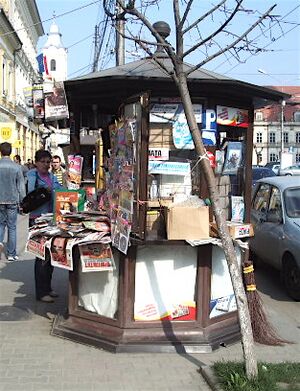
Cluj-Napoca is a big center for media in Transylvania. Many regional TV channels, newspapers, and radio stations are based here. Large national newspapers often have regional versions printed in Cluj-Napoca. There are also local newspapers like Ziua de Cluj and free daily papers.
The city is also important for Hungarian-language media in Romania. The biggest Hungarian newspapers, Krónika and Szabadság, have their offices here.
Local TV stations like TVR Cluj and One TV broadcast in the region. Radio stations like Radio Cluj and the Hungarian-language Paprika Rádió are also based here.
Cluj-Napoca has many magazines covering topics like human resources, shopping, rock music, and tourism. There are also magazines like Șapte Seri and CJ24FUN that cover cultural events and entertainment.
In the early 1900s, Cluj was a key place for making films in Hungary. The first Hungarian film shown worldwide, Sárga csikó ("Yellow Foal," 1912), was made here.
Education
Cluj-Napoca has a long history of higher education. The Babeș-Bolyai University (UBB) is the largest university in Romania, with about 50,000 students. It offers courses in Romanian, Hungarian, German, and English. The university's history goes back to 1581.
The city also has nine other universities. These include the Technical University, the Iuliu Hațieganu University of Medicine and Pharmacy, and the University of Agricultural Sciences and Veterinary Medicine of Cluj-Napoca (USAMV). There are also universities for arts and music.
Public education in Cluj-Napoca dates back to 1409. Today, there are almost 150 schools and kindergartens. Most schools teach in Romanian, but there are also Hungarian-language schools and schools with both Romanian and German or Hungarian classes.
Sports in Cluj-Napoca
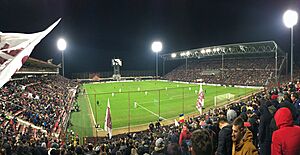
Football (soccer) is very popular in Cluj-Napoca. The city has several football clubs. CFR 1907 Cluj-Napoca is one of the oldest teams in Romania. They have won the Romanian championship eight times and the Romanian Cup four times.
The FC Universitatea Cluj football team was founded in 1919. Their biggest success was winning the Romanian Cup in 1965.
FCU Olimpia Cluj is the local women's soccer team, started in 2010. They have won the Liga I (top league) 10 times and the Romanian Cup 6 times.
Cluj Arena, home to "U" Cluj, is the largest stadium in Cluj-Napoca, with seats for over 30,000 people. It's considered an UEFA Elite stadium. The Dr. Constantin Rădulescu Stadium is home to the CFR Cluj team.
The "Universitatea" club also has teams for other sports like rugby, basketball, handball, and volleyball. The city has many sports facilities, including the BT Arena sports hall, the Sala Sporturilor Horia Demian, and swimming pools. Because of these facilities, Cluj-Napoca often hosts national sports championships.
For car racing fans, Cluj-Napoca hosts two stages of the National Rally Championship: Raliul Clujului and the Avram Iancu Rally.
Amateur athletes can also enjoy swimming pools, miniature golf, tennis courts, and bike paths. In the surrounding areas, you can go skiing, caving, hiking, and more. The Cluj International Marathon is an annual running competition held in the city center.
Partner Cities
Cluj-Napoca is twinned with many cities around the world, helping to build friendships and cultural exchange:
- Dijon, France (1965)
- Nantes, France (1990)
- Zagreb, Croatia (1976)
- Cologne, Germany (1976)
- Pécs, Hungary (1990)
- Beersheba, Israel (1991)
- Columbia, United States (1991)
- Zhengzhou, China (1994)
- Makati, Philippines (1996)
- Suwon, South Korea (1999)
- Chacao (Caracas), Venezuela (1999)
- São Paulo, Brazil (2000)
- Korçë, Albania (2001)
- Province of Parma, Italy (2005)
- Rockford, United States (2005)
- East Lansing, United States (2005)
- Rotherham, England, United Kingdom (2006)
- Viterbo, Italy (2009)
- Namur, Belgium (2010)
- Ningbo, China (2014)
- Ungheni, Moldova (2016)
- Karaganda, Kazakhstan (2017)
- Braga, Portugal (2018)
- Eskişehir, Turkey (2020)
Images for kids
-
St. Michael's Church, the city's largest Gothic-style church
See also
 In Spanish: Cluj-Napoca para niños
In Spanish: Cluj-Napoca para niños


